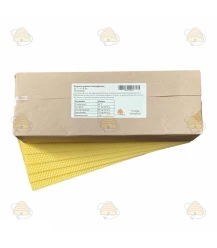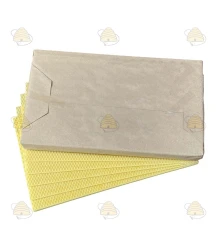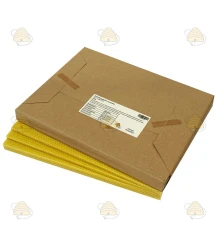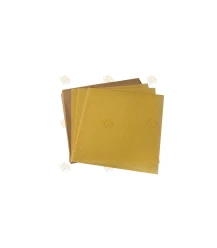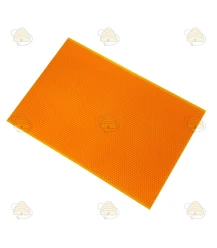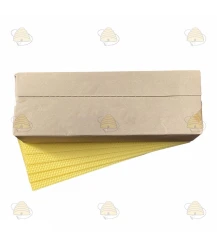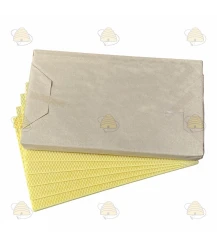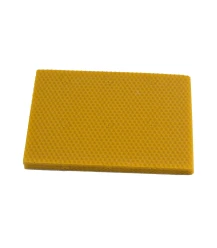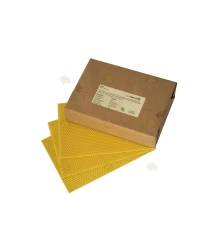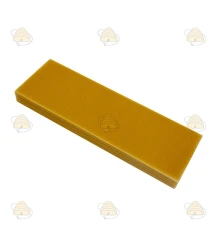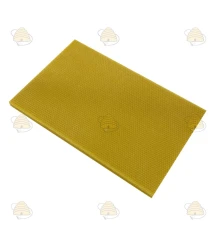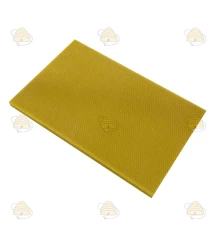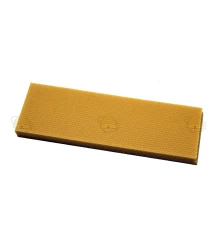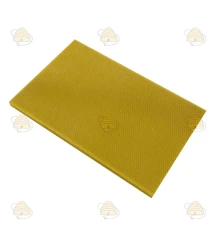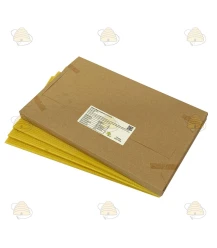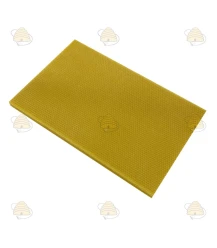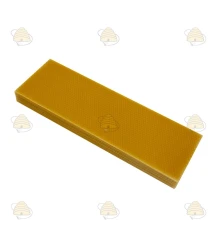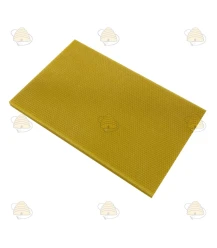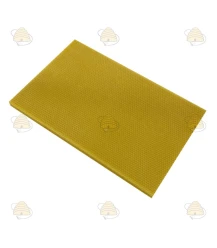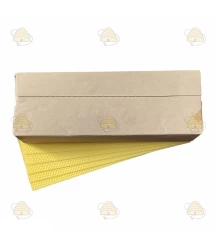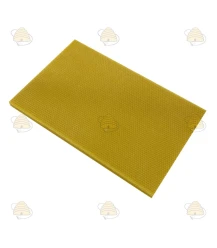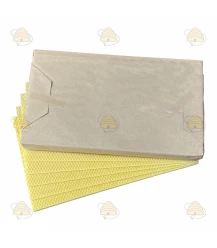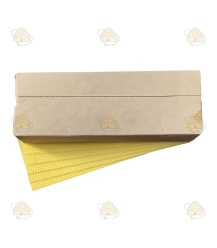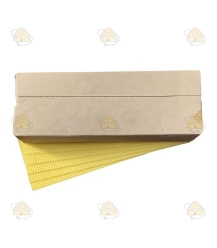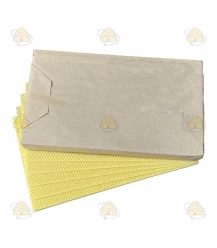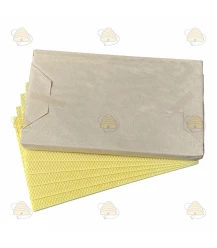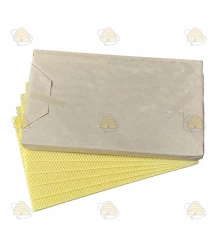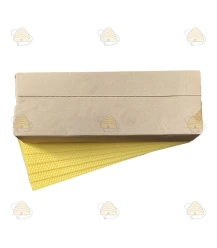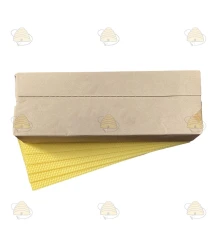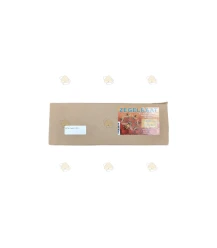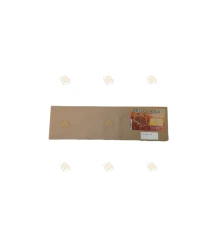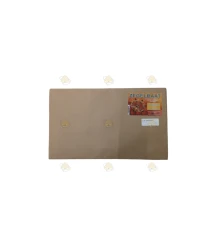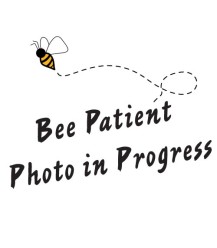Beeswax foundation in various sizes
Beeswax foundation sheets are used by beekeepers in the hive. They are also used to roll beeswax candles. Beeswax foundation is also known by other names, such as foundation sheets, comb foundation, wax sheets, beeswax sheets, starter strips, or wax wafers. There is a lot to cover about beeswax foundation for bees. In this article we explain the basics, so you can make the right choice. When buying beeswax foundation, it is important to choose the correct size. But what size beeswax foundation do I actually need? Beeswax foundation is available in many different sizes. So you need to know which hive and/or frame size you use. In the Netherlands the spaarkast is used; this Dutch spaarkast takes simplex hive frames. You therefore buy beeswax foundation in simplex size. You then choose whether it is for the brood box or for the honey super. There is often a height difference here. And if, for example, you have a Dadant US hive, then you buy beeswax foundation in Dadant US size.
-
simplex cast brood box beeswax foundation per kg
€ 19,95 In stock and available for immediate delivery.Brood box (brood chamber) beeswax foundation in Dutch simplex size. Choose with or without groove in the order menu. Cast beeswax is less prone to warping and can therefore be embedded in the hive frames as early as spring. 1 kg contains approximately 16–17 sheets of high-quality beeswax foundation that bees draw out readily. Beeswax foundation without...View more -
simplex cast beeswax foundation for honey supers per kg
€ 19,95 In stock and available for immediate delivery.Honey super beeswax foundation in Dutch simplex size. Choose with or without groove in the order menu. Cast beeswax warps less easily and can therefore be embedded in the hive frames as early as spring. 1 Kg contains approximately 23 sheets of high-quality beeswax foundation that bees draw out readily. Beeswax foundation without groove fits all simplex...View more -
simplex rolled beeswax honey super beeswax foundation per kg
€ 19,95 Product available with different optionsProduct available with different optionsRolled honey super beeswax foundation in simplex size (for both Dutch and Belgian hive frames). Choose with or without groove in the ordering menu. Rolled beeswax foundation has the advantage that it is less likely to break than cast beeswax foundation. Also suitable for rolling candles and other craft ideas. 1 Kg contains approximately 23 sheets of...View more -
simplex low-residue brood box (brood chamber) beeswax foundation per kg
€ 26,95 In StockCast beeswax foundation in simplex brood box size. For embedding in hive frames. This low-residue beeswax foundation is an alternative to organic beeswax. This beeswax is selected for low levels of pesticide residues. One kilo contains approximately 15-17 sheets. For beekeepers who want only the best for their bees.View more -
simplex low-residue honey super beeswax foundation per kg
€ 26,95 In stock and available for immediate delivery.Beeswax foundation in simplex honey super size, cast beeswax (33.7 x 11.8 cm). For embedding wax foundation in hive frames. The low-residue beeswax foundation is an alternative to organic beeswax. This beeswax is selected for a low pesticide residue content. One kilogram contains approximately 23 sheets. For beekeepers who want only the best for their bees.View more -
simplex rolled beeswax brood box drone foundation per kg
€ 24,95 In stock and available for immediate delivery.Drone-cell beeswax foundation per 1000 g for simplex hive frames. Drone-cell beeswax foundation can be used for the drone brood trapping method to trap Varroa mites. The Varroa mite preferentially reproduces in drone brood comb. Read more about the drone brood trapping method on imkerpedia. Dimensions: 33.3 x 19.3 cm.View more -
simplex DuHoKa cast beeswax foundation per kg
€ 21,95 In stock and available for immediate delivery.Simplex Duhoka beeswax foundation per kg for the Duhoka hive frames. With Duhoka (double honey super) you can easily maintain a larger brood nest by using two honey supers as a brood box (brood chamber). The beeswax foundation measures 33.7 x 26.7 cm and is cast beeswax.View more -
simplex combi frames cast beeswax foundation per kg
€ 21,95 In stock and available for immediate delivery.Cast beeswax foundation for Dutch combi hive frames. The size of this beeswax foundation is 33.7 x 34.5 cm.View more -
Plastic foundation 28 x 41 cm
€ 4,70 This product is ordered, delivery time is approximately 14 days.Yellow plastic foundation sheet measuring 28 x 41 cm. Ideal if you want to install plastic foundation in your hive frames yourself. This foundation sheet is made of a rigid plastic that remains slightly flexible. Before use, the plastic foundation should be coated with beeswax so the bees can draw out the comb further. Price per piece. Cell size...View more -
German Normal honey super beeswax foundation per kg (for 159 mm hive frames)
€ 19,95 In stock and available for immediate delivery.Cast honey super beeswax foundation in German Normal size. This beeswax foundation is suitable for installing in the hive frames of German Normal hives. The dimensions are 34.7 x 14 cm.View more -
German Normal brood box (brood chamber) beeswax foundation per kg
€ 19,95 In stock and available for immediate delivery.Cast beeswax foundation for the brood box in German Normal size. This beeswax foundation is suitable for fitting the hive frames in German Normal hives. The dimensions are 34.7 x 19.7 cm.View more -
MiniPlus beeswax foundation per kg
€ 19,95 In stock and available for immediate delivery.Cast beeswax foundation in MiniPlus size. This beeswax foundation is suitable for embedding into the hive frames in MiniPlus boxes. The dimensions are 19 x 13.8 cm. One pack contains approximately 44 sheets of beeswax foundation.View more -
Warré beeswax foundation per kg
€ 19,95 In stock and available for immediate delivery.Cast beeswax foundation in Warré size. This beeswax foundation is suitable for the hive frames in Warré hives. The dimensions are 26,5 x 18 cm. Hive frames for the Warré hive [product id=1546]can be found here.[/product]View more -
Apimaye Langstroth / Dadant honey super beeswax foundation per kg
€ 19,95 In stock and available for immediate delivery.Apimaye Langstroth / Dadant honey super beeswax foundation packed per 1 kg. Use this to fit Langstroth / Dadant honey super hive frames with foundation. The beeswax foundation is cast beeswax and measures 42 x 13 cm. Note: this beeswax foundation is specially made for the hive frames of the Langstroth / Dadant Apimaye beehive.View more -
Apimaye Dadant brood box (brood chamber) beeswax foundation per kg
€ 19,95 This product is ordered, delivery time is approximately 14 days.Apimaye Dadant brood box beeswax foundation packed per 1 kg. With this you can fit the Apimaye Dadant brood box hive frames with beeswax foundation. The beeswax foundation is cast and measures 41.5 x 27 cm. Note: this beeswax foundation is specially made for the hive frames of the Apimaye Dadant beehive.View more -
Apimaye Langstroth brood box beeswax foundation per kg
€ 19,95 In stock and available for immediate delivery.Apimaye Langstroth brood box (brood chamber) beeswax foundation, sold per 1 kg pack. Use this to fit Langstroth brood box (brood chamber) hive frames with foundation. This is cast beeswax foundation and measures 42 x 20 cm. Note: this beeswax foundation is specially made for the hive frames of the Apimaye Langstroth beehive.View more -
Langstroth honey super beeswax foundation per kg
€ 19,95 In stock and available for immediate delivery.Cast beeswax foundation in Langstroth honey super (1/2) size. This beeswax foundation fits Langstroth honey super hive frames. The dimensions are 41 x 13 cm.View more -
Langstroth brood box (brood chamber) beeswax foundation per kg
€ 19,95 In stock and available for immediate delivery.Cast beeswax foundation in Langstroth brood box size. This beeswax foundation is suitable for fitting the brood box hive frames of a Langstroth hive. The dimensions are 41 x 19.5 cm.View more -
Dadant US & Langstroth cast beeswax honey super beeswax foundation per kg
€ 19,95 In stock and available for immediate delivery.Cast beeswax foundation Dadant US, for fitting in the honey super frames. The dimensions of this Dadant US beeswax foundation are 42 x 12 cm. One kilo contains approximately 21 sheets of Dadant US beeswax foundation. This size also fits Langstroth honey super frames with a height of 159 mm.View more -
Dadant US cast beeswax brood box (brood chamber) per kg
€ 19,95 In stock and available for immediate delivery.Cast beeswax foundation, Dadant US brood box size. To fit Dadant US brood box hive frames with beeswax foundation. The dimensions are 42 x 25,5 cm. A 1 kg pack contains approximately 10 sheets of beeswax foundation.View more -
Dadant Blatt honey super beeswax foundation per kg
€ 19,95 In stock and available for immediate delivery.Cast or rolled (option) beeswax foundation in size Dadant Blatt (Frankenbeute) 1/2. To fit Dadant Blatt honey super hive frames with beeswax. The dimensions are 41.3 x 13 cm.View more -
Dadant Blatt brood box (brood chamber) beeswax foundation per kg
€ 19,95 In stock and available for immediate delivery.Cast beeswax foundation for brood box in size Dadant Blatt (Frankenbeute). To fit the Dadant Blatt brood box hive frames with beeswax foundation. The dimensions are 41,3 x 26,3 cm. In 1,000 g there are approximately 10 Dadant Blatt brood box sheets.View more -
Dalinno Langstroth brood box (brood chamber) beeswax foundation per kg
€ 19,95 In stock and available for immediate delivery.Cast beeswax foundation, Dalinno Langstroth brood box size. This beeswax foundation is suitable for installing in Dalinno Langstroth brood box hive frames. The size of the Dalinno Langstroth brood box beeswax foundation is 43.8 x 22.4 cm.View more -
Dalinno Langstroth honey super beeswax foundation per kg
€ 19,95 In stock and available for immediate delivery.Cast beeswax foundation in Dalinno Langstroth honey super (1/2) size. This beeswax foundation is suitable for equipping Dalinno Langstroth honey super hive frames with beeswax foundation. The dimensions are 43,8 x 15,1 cm.View more -
Zander brood box beeswax foundation per kg
€ 19,95 In stock and available for immediate delivery.Cast beeswax foundation in Zander brood box (brood chamber) size. This beeswax foundation is suitable for fitting into Zander brood box (brood chamber) hive frames. The dimensions of this beeswax foundation are 39.4 x 19.6 cm. The beeswax foundation is supplied in 1 kg packs.View more -
Zander honey super beeswax foundation per kg
€ 19,95 In stock and available for immediate delivery.Cast beeswax foundation in Zander honey super size. This beeswax foundation is suitable for Zander honey super hive frames. The dimensions of the foundation are 39.6 x 13.6 cm. The foundation is packed per 1 kg.View more -
Kempische honey super beeswax foundation per kg
€ 19,95 In stock and available for immediate delivery.Cast beeswax foundation for Kempische honey super frames. This beeswax foundation is suitable for use in the honey super frames of Kempische beehives. The dimensions of the foundation are 31.5 x 13.7 cm. The foundation is packed per 1 kg.View more -
Kempische brood box (brood chamber) beeswax foundation per kg
€ 19,95 In stock and available for immediate delivery.Cast beeswax foundation in Kempische brood box size. This beeswax foundation is suitable for fitting the Kempische beehive’s brood box hive frames with beeswax foundation. The dimensions of the beeswax foundation are 31.5 x 25.5 cm. The beeswax foundation is packaged per kilogram.View more -
Simplex/spaarkast rolled beeswax brood box beeswax foundation cell size 4.9 per kg
€ 21,95 In StockBrood box (brood chamber) beeswax foundation in Dutch simplex size with a 4.9 mm cell size. Beeswax foundation without saw cut fits all simplex hive frames. 1 kg contains approximately 16-17 sheets of high-quality beeswax foundation that bees draw out well. Dimensions without saw cut: 33,7 x 19,5 cm.View more -
simplex/spaarkast honey super rolled beeswax foundation cell size 4.9 per kg
€ 21,95 In StockHoney super beeswax foundation in Dutch simplex size with a 4.9 cell size. Beeswax foundation without saw cut fits all simplex frames. 1 kg contains approximately 23 sheets of high-quality beeswax foundation that bees readily draw out. Dimensions without saw cut: 33.7 x 11.8 cm (ZZ).View more -
Simplex/spaarkast rolled beeswax honey super foundation cell size 5.1 per kg
€ 21,95 In StockHoney super beeswax foundation in Dutch simplex size with a cell size of 5.1. Beeswax foundation without saw cut fits all simplex hive frames. 1 Kg contains approximately 23 sheets of premium beeswax foundation that bees draw out readily. Size without saw cut: 33.7 x 11.8 cm.View more -
Simplex/spaarkast rolled brood box (brood chamber) beeswax foundation cell size 5.1 per kg
€ 21,95 In StockBrood box beeswax foundation in Dutch simplex size with a 5.1 cell size. Cast beeswax is less prone to warping and can therefore be embedded in the hive frames as early as spring. Foundation without notch fits all simplex hive frames. 1 kg contains approximately 16-17 sheets of high-quality beeswax foundation that the bees draw out very well....View more -
simplex/spaarkast rolled beeswax brood box foundation low-residue cell size 4.9 per kg
€ 29,95 In StockLow-residue rolled brood box beeswax foundation, cell size 4.9, Without saw cut, in the Dutch simplex size for, among others, the spaarkast. This low-residue beeswax foundation is an alternative to organic beeswax. This beeswax is selected for a low level of pesticide residues. Rolled beeswax foundation has the advantage that it breaks less easily than...View more -
Simplex/Spaarkast brood box low-residue rolled beeswax foundation cell size 5.1 per kg
€ 29,95 Out of stockOut of stockLow-residue rolled brood box beeswax foundation, cell size 5.1, Without saw cut, in Dutch simplex size for, among others, the spaarkast. The low-residue beeswax foundation is an alternative to organic beeswax. This beeswax is selected for a low residue level of pesticides. Rolled beeswax foundation has the advantage that it is less likely to break than...View more -
simplex/spaarkast rolled honey super low-residue beeswax foundation cell size 5.1, per kg
€ 29,95 In StockLow-residue rolled honey super beeswax foundation, cell size 5.1, Without Saw Cut, in Dutch simplex size. The low-residue beeswax foundation is an alternative to organic beeswax. This beeswax is selected for a low pesticide residue level. Rolled beeswax foundation has the advantage that it is less likely to break than cast beeswax foundation. 1000 grams...View more -
simplex/spaarkast rolled beeswax honey super low-residue beeswax foundation cell size 4.9, per kg
€ 29,95 In StockLow-residue rolled beeswax foundation for honey super, cell size 4.9, Without Saw Cut, in Dutch simplex size. The low-residue beeswax foundation is an alternative to organic beeswax. This beeswax is selected for a low pesticide residue content. Rolled beeswax foundation is less likely to break than cast beeswax foundation. 1 KG of beeswax foundation...View more -
simplex rolled brood box beeswax foundation per kg
€ 19,95 Out of stockOut of stockRolled brood box beeswax foundation per 1 kg in simplex size (for both Dutch and Belgian hive frames). Select with or without saw-kerf in the order menu. Rolled beeswax foundation has the advantage that it is less likely to break than cast beeswax foundation. Also suitable for rolling candles and other craft projects. 1 Kg contains approximately 16 / 17...View more -
Comb foundation, simplex cast beeswax brood box beeswax foundation per kg
€ 29,95 In StockCappings wax foundation in simplex brood box size is probably the best beeswax foundation you could wish for your bees. It is a beeswax foundation made from cappings wax. Cappings wax is the beeswax bees produce in the cells to cap the honey, making it very pure. This beeswax is released during uncapping and honey harvest. These cappings are washed with...View more -
Thin super, Simplex cast honey super beeswax foundation per kg
€ 29,95 In StockCappings wax foundation in simplex honey super size is probably the best beeswax foundation you could wish for your bees. It is a beeswax foundation made from cappings wax. Cappings wax is the beeswax bees build on the cells to cap the honey and is therefore very pure. This beeswax is released during uncapping and honey harvesting. These cappings are...View more -
Thin super foundation, German Normal honey super cast beeswax foundation per kg (for 159 mm frames)
€ 29,95 In StockCappings wax foundation in German Normal (DN) honey super size is probably the best beeswax foundation (cast beeswax) you could wish for your bees. It is a beeswax foundation made from cappings wax. Cappings wax is the beeswax that bees produce to cap the honey cells and is therefore very pure. This beeswax is released again during uncapping and...View more -
Thin super, Dadant US & Langstroth cast beeswax honey super foundation per kg
€ 29,95 In StockCappings wax foundation in honey super size for Dadant US & Langstroth is probably the best beeswax foundation you could wish for your bees. It is a beeswax foundation made from cappings wax. Cappings wax is the beeswax that bees produce to seal honey cells and is therefore very pure. This beeswax is recovered during uncapping and extracting the...View more -
Beeswax foundation, Dadant US cast beeswax brood box per kg
€ 29,95 In StockCappings wax foundation in Dadant US cast beeswax brood box (brood chamber) size is probably the best beeswax foundation you could wish for your bees. It is a beeswax foundation made from cappings wax. Cappings wax is the beeswax that bees produce in the cells to seal the honey and is therefore very pure. This beeswax is recovered during uncapping and...View more -
Dadant US brood box rolled beeswax foundation cell size 5.1 per kg
€ 21,95 In StockRolled brood box beeswax foundation per 1000 grams for the Dadant US brood box with cell size 5.1 (no saw cut). Rolled beeswax foundation has the advantage that it is less prone to breaking than cast beeswax foundation. This foundation is made of excellent quality that bees draw out well. Foundation size: 41.3 x 26.3 cm.View more -
Voirnot honey super cast beeswax foundation per kg
€ 19,95 In StockHoney super cast beeswax foundation Without Saw Cut in size 1/2 Voirnot, packed per 1,000 grams. This beeswax foundation is excellent quality and is readily drawn by the bees. Beeswax foundation dimensions: 32.5 cm x 16.5 cm.View more -
Voirnot brood box (brood chamber) cast beeswax foundation per kg
€ 19,95 In StockBrood box (brood chamber) cast beeswax foundation Without Saw Cut in Voirnot size, packed per 1000 g. This beeswax foundation is of excellent quality and bees draw it out very well. Beeswax foundation dimensions: 32.5 cm x 32.5 cm.View more
Cast or rolled beeswax foundation
When making beeswax foundation, there are two production methods. One casts the foundation; the other rolls it. In the cast foundation process, the molten wax is poured into rollers with a honeycomb pattern. This honeycomb comes out ready to cut to size and use.
For rolled foundation, the process has two steps. First, beeswax is also poured between two rollers, but these have no pattern, producing a very long sheet of beeswax. This sheet is rolled up. In the second step, the sheet is run through patterned rollers to emboss the honeycomb.
Cast beeswax foundation is the most widely used. It remains dimensionally stable once mounted in the hive frames. It is slightly thicker, making it easier to use and to store in the frame. The honeycomb imprint is also very precise. Rolled beeswax foundation is thinner. The benefit is you get slightly more sheets from 1 kg of beeswax. The drawback is that once in the frame it can sag and bulge. Sometimes a heavier gauge is rolled to reduce this effect. In practice you shouldn’t store frames with rolled foundation; use them straight away in the beehive. And it shouldn’t be too warm, otherwise it may warp in the hive as well. The cell shape can also be a bit elongated because it is pressed and pulled through the machine.
Making your own beeswax foundation
You can also make your own beeswax foundation. A very simple method is to melt beeswax in a pan and ladle it onto a silicone mat with a honeycomb pattern. Another option is to purchase a professional, water-cooled unit. The advantage is faster throughput: after pouring, the sheet is cooled immediately.
Beeswax in different grades
Beeswax comes in different grades. There is conventional beeswax, meaning wax sourced from beekeeping operations. This can be from the Netherlands or other countries. Lots are blended and checked. A perfectly good, standard-grade beeswax.
Alongside this there is low-residue beeswax, sometimes sold as selected beeswax. This wax naturally contains fewer contaminants. As a result it is purer in quality, with little to no residues from possible earlier varroa treatments. It resembles organic beeswax in composition, but it is not certified organic.
There is also a third type of beeswax: cappings wax, one of the purest forms of beeswax. Cappings are collected during harvesting honey, before any pre-treatment has occurred, as this happens only after the honey harvest from the hive. You won’t find any varroa treatments in it. In addition, this beeswax has not previously been processed into foundation. This beeswax is of very high quality. It does not need to be cleaned; it can be washed with water, then heated and embossed into beeswax foundation for the beehive.
With all these options, buying beeswax foundation can feel like a task. What is the best type of beeswax for you? As a baseline, conventional beeswax is perfectly fine. But you’ll find bees accept low‑residue beeswax or cappings wax very quickly. It can also be a choice in your beekeeping operation: what suits you, and what budget is available? Conventional beeswax is usually the cheapest and a solid choice, followed by low‑residue beeswax, with cappings wax the most expensive.
Different cell sizes in beeswax foundation
Beeswax foundation also comes in different cell sizes. The standard cell size used is 5.4 mm. In reality it is slightly smaller but rounded to 5.4 mm. This is the most commonly used foundation. In addition there are three other sizes: 5.1 mm, 4.9 mm and 6.3 mm. The idea behind these sizes is to be closer to the natural cell size of the honey bee. In nature, bees build cells ranging from 4.62 mm to 5.51 mm. You can choose a smaller size to come closer to the bees’ average cell size. Despite this concept, 5.4 mm remains the standard in beekeeping. There is also the larger 6.3 mm, used for drone brood. Using this foundation you can rear drones (male bees) in the colony. This can be desirable if you use alternative varroa control, by trapping varroa in drone brood, or in queen rearing when you want to produce many drones.
Beeswax foundation for making candles
Finally, beeswax foundation is also used for making candles. It’s a very simple and fun process: lay down the wick, roll up the beeswax sheet and you have a candle. You can even cut shapes so you can roll a beehive. There are handy starter kits available, complete with wick and sometimes little bees to decorate the candles. Foundation for candle making is also available in different colors, so you can make a colored candle or decorate a rolled candle.
For rolling beeswax candles the wax needs to be slightly warm, otherwise it can crack. The best wax for this is rolled beeswax, as it is thin and flexible. Cast wax also works fine; just make sure it isn’t too cold. If you’re working in a cool room, you can warm the wax briefly with a hair dryer. Which beeswax foundation sheet you choose for candles doesn’t really matter in terms of size: a large sheet gives a large candle, a small sheet a smaller candle. Foundation is almost always sold by the kilogram, so the sheet size doesn’t affect the price.


